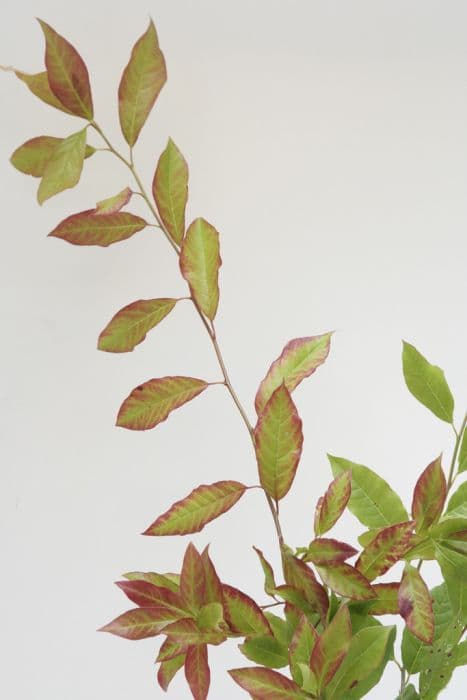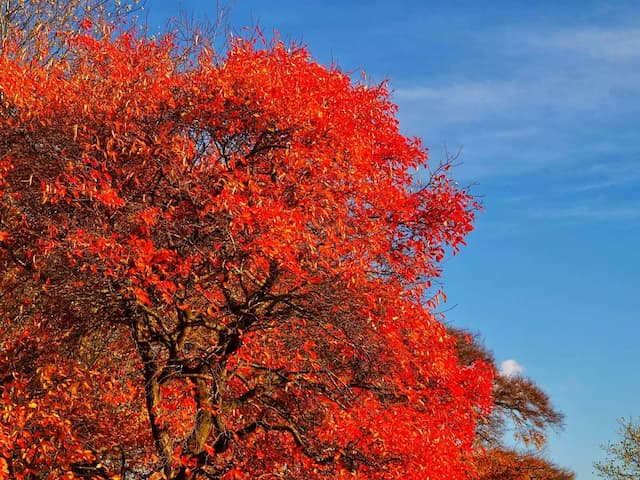Dove tree Davidia involucrata 'Crimson Spring'
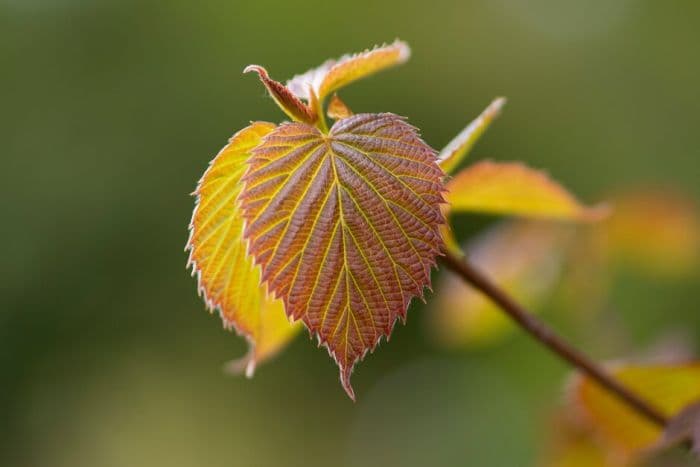
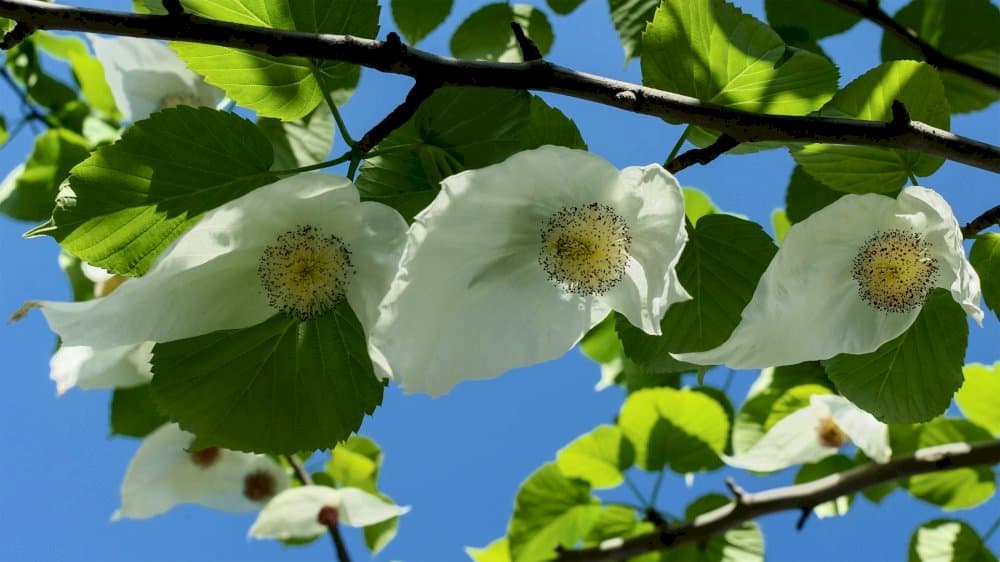

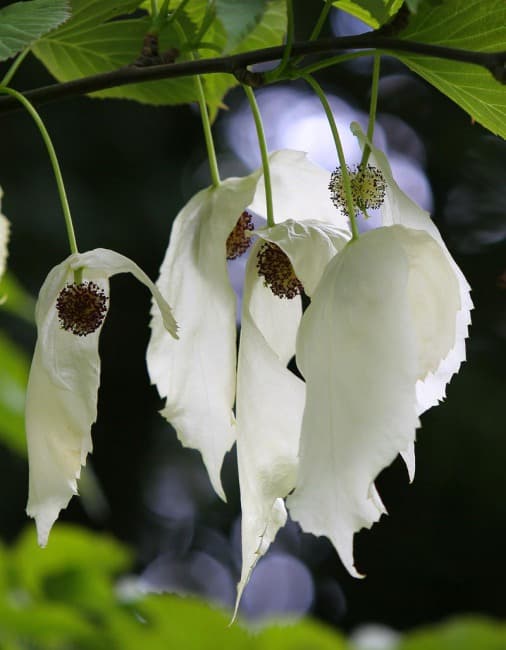
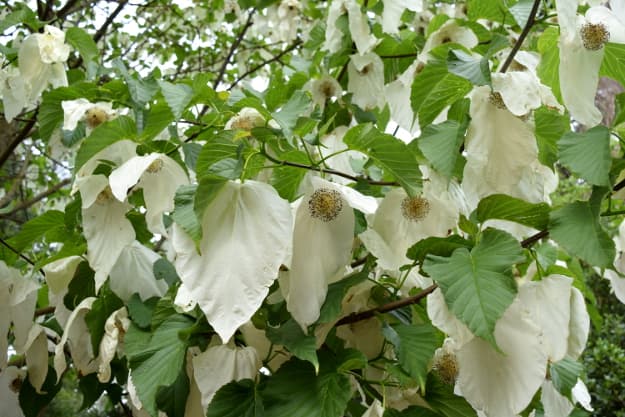
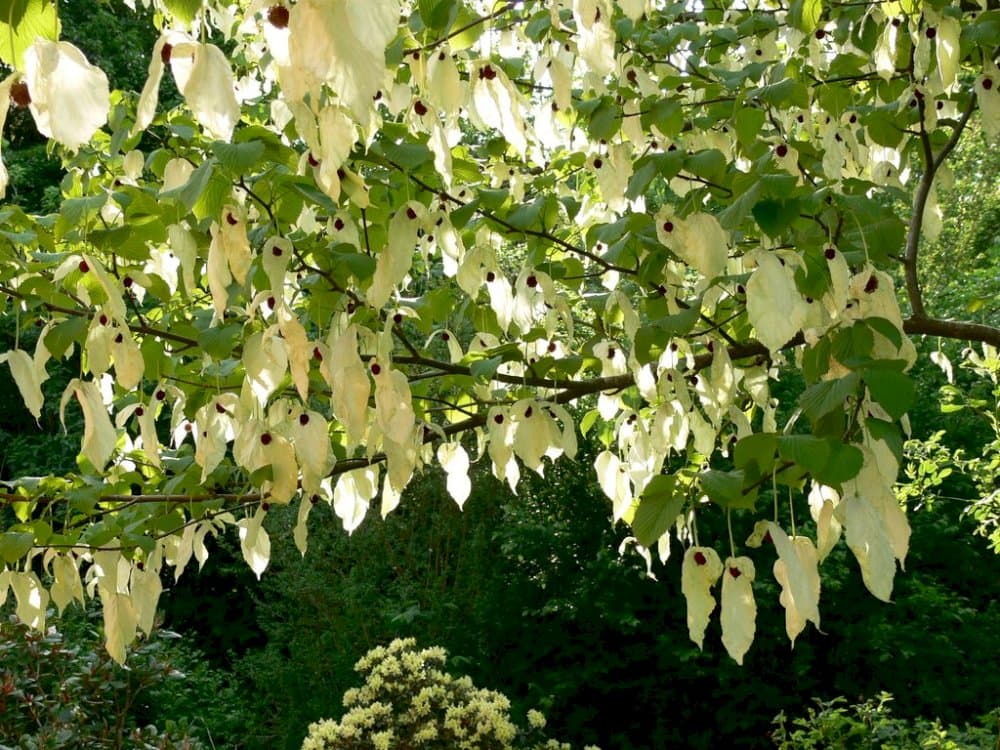
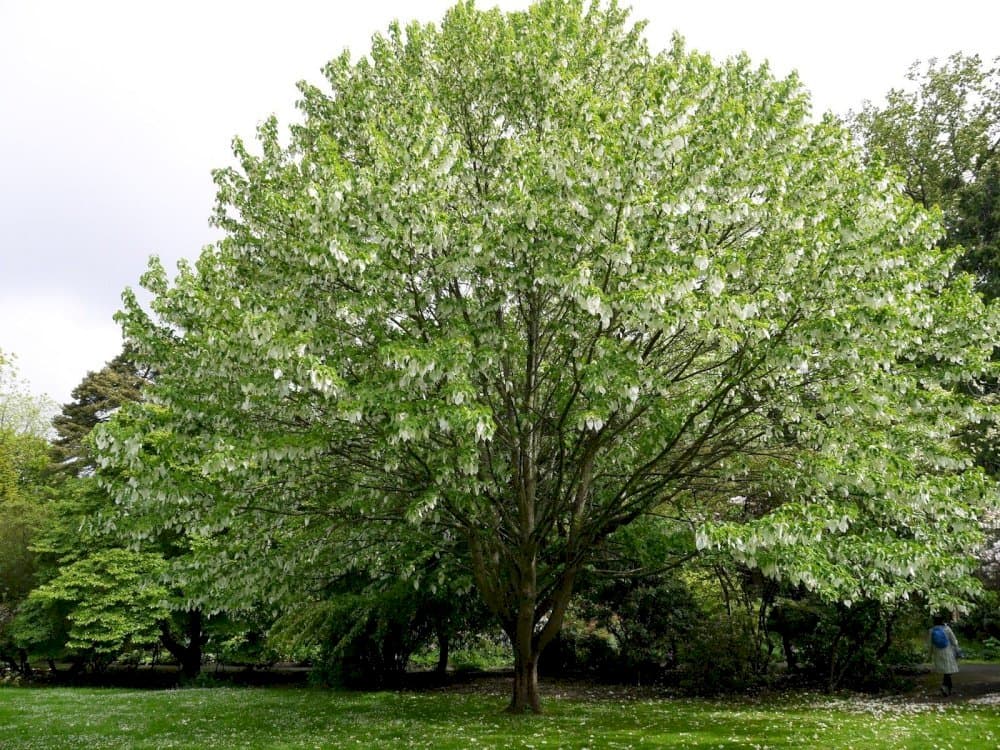
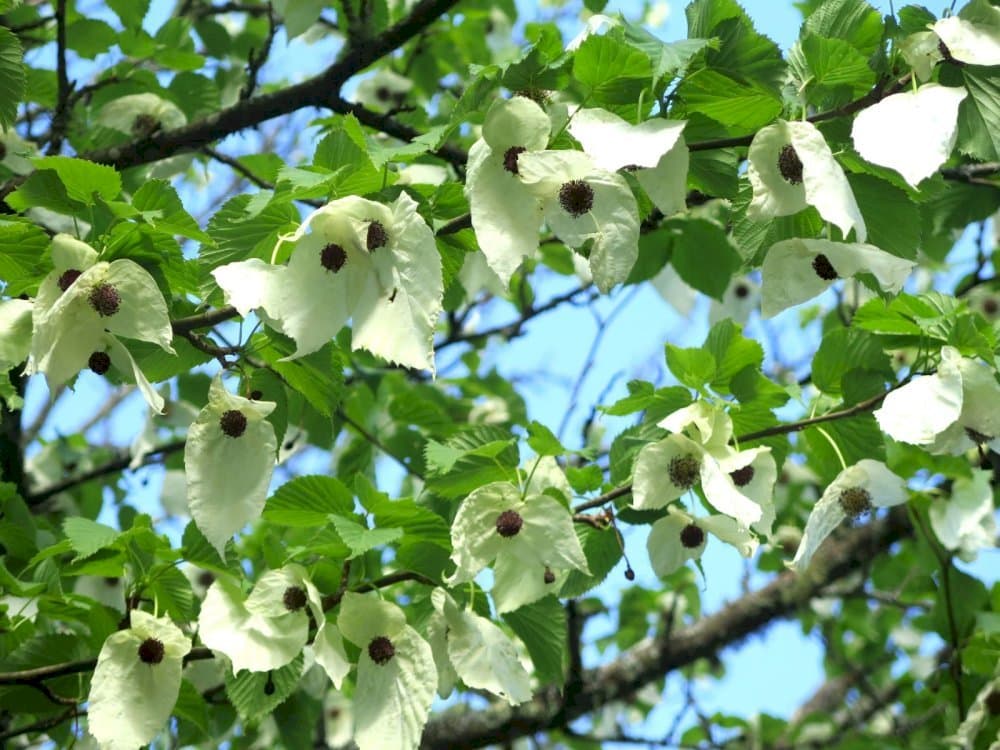
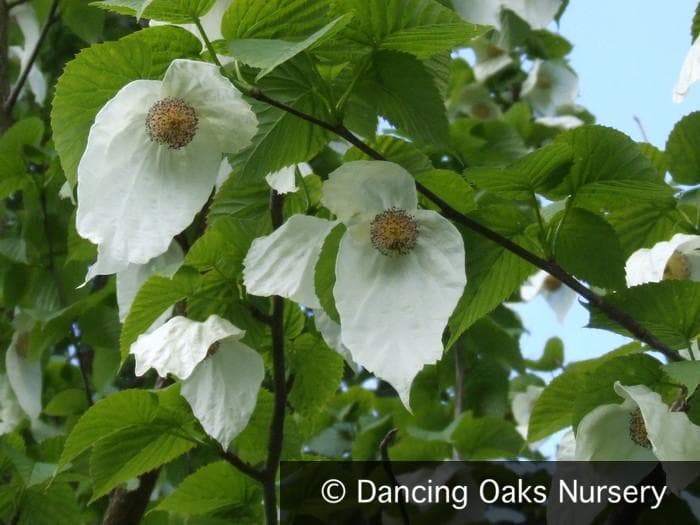
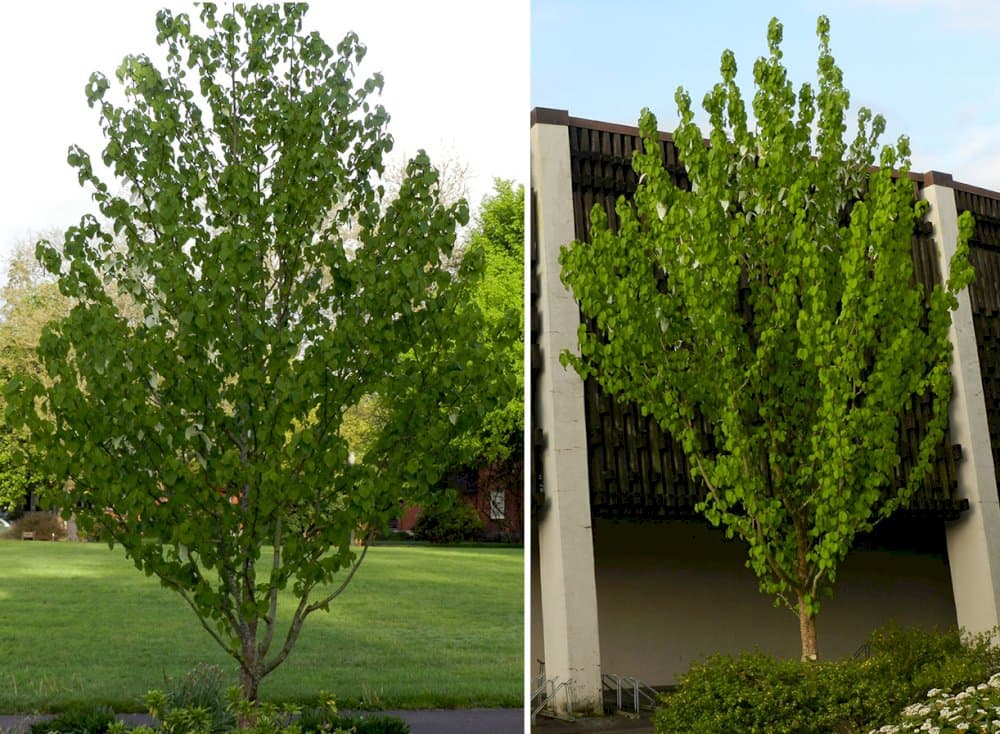
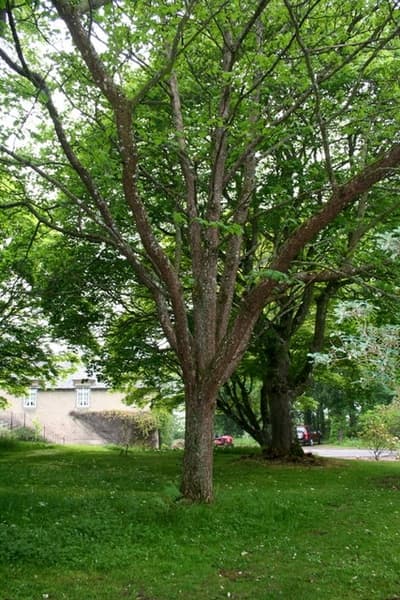
ABOUT
The Davidia involucrata 'Crimson Spring', also commonly known as the handkerchief tree or dove tree, is notable for its unique and striking appearance, particularly during its blooming season. One of its most distinctive features is its floral bracts, which are large, white, and petal-like, creating the illusion of handkerchiefs or fluttering doves hanging from the branches. These bracts surround the actual flowers, which are small and found in clusters at the center. 'Crimson Spring' is a variety that distinguishes itself with red-tinted young leaves when they first emerge, providing a colorful contrast to the white bracts and the green mature foliage that follows. Over time, as the foliage matures, it transitions to a deep green, creating a lush backdrop for other phases of the plant's blooming cycle. The leaves themselves are heart-shaped, with a textured surface and a serrated edge. In addition to the appealing foliage, the tree bears round, green fruit that eventually turns to a purple-brown as it matures. These fruits are not particularly ornamental but do add another element of interest to the tree's overall appearance. The dove tree's intriguing blend of colorful foliage, unique bracts, and modest fruit makes it a standout specimen in any garden setting where its aesthetic qualities can be displayed to full effect.
About this plant
 Names
NamesFamily
Nyssaceae
Synonyms
Dove Tree, Handkerchief Tree, Ghost Tree, Pocket Handkerchief Tree, Laudanum Tree
Common names
Davidia involucrata.
 Toxicity
ToxicityTo humans
The Davidia involucrata, commonly known as the Dove Tree, is not known for being toxic to humans. There are no commonly reported symptoms of poisoning from ingesting any part of this plant. Thus, the Dove Tree is considered non-toxic and should not pose a risk of poisoning if accidentally consumed.
To pets
Similar to its effects on humans, the Dove Tree is not considered toxic to pets. There are no specific symptoms associated with poisoning from ingesting parts of the Dove Tree as it is generally regarded as safe for animals. Therefore, pet owners should not expect toxicity or dangerous consequences if their pets happen to consume parts of this plant.
 Characteristics
CharacteristicsLife cycle
Perennials
Foliage type
Deciduous
Color of leaves
Green
Flower color
White
Height
20-25 feet (6-7.5 meters)
Spread
15-20 feet (4.5-6 meters)
Plant type
Tree
Hardiness zones
6
Native area
China
Benefits
 General Benefits
General Benefits- Ornamental value: The handkerchief or dove tree (Davidia involucrata 'Crimson Spring') is highly valued for its unique and striking flowers that resemble handkerchiefs or doves, adding a dramatic display to any landscape.
- Seasonal interest: This plant provides seasonal interest with its springtime crimson-pink bracts that gradually turn to white, and its autumn foliage that turns to a vibrant mix of yellow, orange, and red.
- Shade provision: As a medium to large-sized deciduous tree, it can offer considerable shade once mature, making it ideal for parks, gardens, and as a street tree.
- Habitat support: The tree is beneficial to wildlife, providing habitat and food for various bird and insect species.
- Drought resistance: Once established, the handkerchief tree is relatively drought-tolerant, requiring less maintenance and water than some other ornamental trees.
- Rarity and uniqueness: Owing to its distinctive appearance and the rarity of flowering specimens, the tree can be a focal point for plant collectors and enthusiasts.
 Medical Properties
Medical PropertiesThis plant is not used for medical purposes.
 Air-purifying Qualities
Air-purifying QualitiesThis plant is not specifically known for air purifying qualities.
 Other Uses
Other Uses- Handkerchief Tree bark can be used to create a natural dye for fabrics, offering a range of soft, earthy tones depending on the mordant used.
- The wood of the Handkerchief Tree is sometimes used in fine woodworking or to make decorative objects, thanks to its moderate hardness and grain texture.
- The large bracts of the Handkerchief Tree can be used in floral arrangements and as a unique natural decoration for events and ceremonies.
- Leaves from the Handkerchief Tree can be used to make eco-friendly leaf mould, providing nutritious compost for gardens and landscapes when decomposed.
- Handkerchief Tree seeds are occasionally used in craft projects or as educational tools to demonstrate the life cycle of flowering plants.
- The dense foliage of the Handkerchief Tree provides excellent shelter and nesting opportunities for a variety of bird species.
- The Handkerchief Tree's distinctive appearance makes it a valuable specimen for botanical studies and plant identification training.
- In larger landscapes, Handkerchief Trees can be used as natural screens or hedges to create privacy or windbreaks.
- During autumn, the Handkerchief Tree's leaves can add to the biomass of organic mulch after they fall, enriching the soil as they break down.
- As a subject of photography and painting, Handkerchief Tree's unique blooms inspire artists and nature lovers, capturing the fleeting beauty of its bracts and flowers.
Interesting Facts
 Feng Shui
Feng ShuiThe Dove Tree is not used in Feng Shui practice.
 Zodiac Sign Compitability
Zodiac Sign CompitabilityThe Dove Tree is not used in astrology practice.
 Plant Symbolism
Plant Symbolism- Peace: The Davidia involucrata, commonly known as Dove Tree, produces white bracts that resemble doves perched amongst its branches, symbolizing peace and the Holy Spirit.
- Purity: The Dove Tree's white bracts are often associated with purity and innocence, much like white doves themselves.
- Beauty in Isolation: Since this tree is a solitary bloomer, its uniqueness when it stands alone full of white bracts lends it to symbolize the beauty and strength found in solitude.
- Spiritual Enlightenment: Because of its dove-like appearance, the Dove Tree is seen as a symbol of spiritual enlightenment and the quest for higher knowledge, as doves are often considered messengers.
- Resilience: The Dove Tree is known for its hardiness in different growing conditions, representing resilience in the face of adversity.
 Water
WaterThe Handkerchief tree should be watered deeply, ensuring that the soil is moist but not waterlogged. During its growing season in spring and summer, water approximately every week, providing around 1 to 1.5 gallons per watering session for young trees. Mature trees may require less frequent watering but with greater volumes, tailored to their size and the soil's ability to retain moisture. In the absence of rain, check the soil moisture level a few inches down; if dry, it's time to water. In the winter, reduce watering frequency as the tree’s water requirements decrease.
 Light
LightThe Handkerchief tree prefers a spot with dappled sunlight or partial shade. It thrives under the filtered light of taller trees, as direct, hot sun can harm the foliage, especially in the southern parts of its range. The ideal location would offer some protection from the harsh afternoon sun while providing ample morning light or high canopy-filtered light throughout the day.
 Temperature
TemperatureThe Handkerchief tree can endure a temperature range from approximately 20°F to 85°F. While it can survive occasional dips below this range, prolonged exposure to temperatures outside these limits can be harmful. The ideal growing conditions for this tree are in a temperate climate with moderate summer and cool winter temperatures.
 Pruning
PruningThe Handkerchief tree requires minimal pruning, mainly to maintain shape and remove any damaged or crossing branches. Prune in late winter or early spring before new growth begins. This is also an opportune time to remove any suckers or unwanted shoots. Pruning should be done sparingly, as the tree naturally forms an attractive shape.
 Cleaning
CleaningAs needed
 Soil
SoilThe Dove Tree prefers a rich, well-drained loamy soil with a pH between 6.0 and 7.0. A mixture of garden soil, compost, and perlite or vermiculite is ideal to ensure moisture retention and good drainage.
 Repotting
RepottingThe Dove Tree, being a large garden tree, is not typically repotted. It's planted outdoors where it has space to grow and will not need repotting.
 Humidity & Misting
Humidity & MistingThe Dove Tree thrives in average outdoor humidity levels; it does not require specific humidity adjustments when grown in its natural environment.
 Suitable locations
Suitable locationsIndoor
Dove Trees are large and best suited outdoors.
Outdoor
Plant in well-draining soil; full sun to partial shade.
Hardiness zone
6-8 USDA.
 Life cycle
Life cycleThe Handkerchief Tree, or Davidia involucrata 'Crimson Spring', begins its life as a seed, which requires stratification to germinate properly. Upon germination in early spring, the seedling emerges and establishes a root system, with growth acceleration during warm seasons. As the tree matures, it develops distinctive heart-shaped leaves and, after several years (often 10 years or more), it starts to flower, showing its notable white bracts that resemble handkerchiefs. Following pollination by insects, the tree produces a hard, nut-like fruit, which houses the seeds for dispersal. Each autumn, the tree sheds its leaves, entering a dormant phase during winter, conserving energy for the next growth cycle. This cycle continues annually with the tree increasing in size and canopy spread, potentially reaching heights of 20-25 meters over several decades.
 Propogation
PropogationPropogation time
Spring-Early Summer
Propogation: The most popular method of propagating Davidia involucrata 'Crimson Spring', commonly known as the Dove Tree or Handkerchief Tree, is through seed sowing. The best time to sow seeds is in the fall, right after they are collected, allowing them to undergo a natural stratification process during the winter months. Fresh seeds should be sown in a cold frame or outdoor seedbed. It's important to cover the seeds with a thin layer of soil—about twice the thickness of the seed. As the Dove Tree seeds have a double dormancy, it can take them up to 18 months to germinate. To increase the chances of germination, seeds may be soaked in warm water for 24 hours before planting. Patience is a virtue with this method, as it may take several years for the trees grown from seed to flower.
